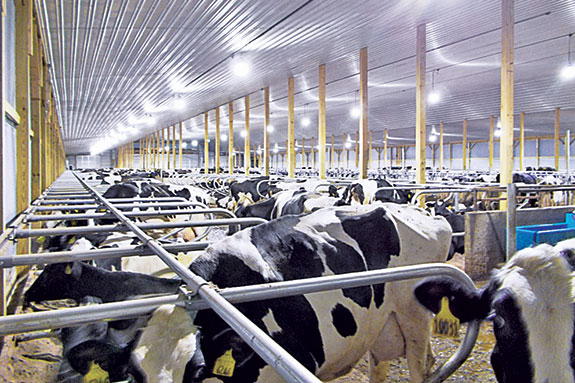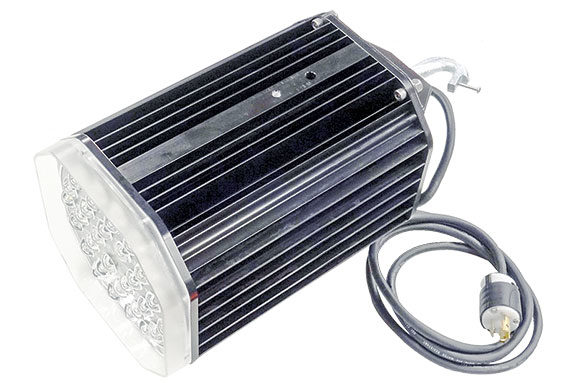It’s been said that “it’s hard to be a bright light in a dim world.” For success to be achieved, the environment must provide the essential components. New research brings this statement to light: Proper parlor and dairy facility lighting may play a role in herd performance and an operation’s bottom line.
Research from the University of Minnesota shows cows and heifers require adequate light levels on a consistent basis.
The light helps them generate appropriate hormonal responses for optimal growth, milk production and routine movement. Adequate lighting has also proven to increase feed intake when ideal lighting is positioned properly.
But which lighting is best and how can producers find lighting success? The answer to these questions comes from first evaluating the options. There are several lighting choices on the market today. The most common and traditional is metal halide lighting â the oldest technology on the market.
Though it was once a breakthrough in parlor lighting, many improvements in efficiency, durability and bulb brightness have been made to dairy lighting since metal halide lighting hit the market.
The second form of lighting used in dairy facilities is fluorescent lighting. Fluorescent lights (T5 or T8 fluorescent tube lights being the most common today) first became popular because they are inexpensive to purchase and provide 50 percent greater energy efficiency than metal halide lighting.
However, they require high maintenance, can perform poorly under extreme temperatures and often contain mercury, which can be problematic if the fixture breaks.
Noticing room for improvement in both lighting options, dairy producers and researchers have begun to install light emitting diode (LED) fixtures in dairy facilities. LED lights do not contain mercury and can provide economic benefits through fewer maintenance costs and greater bulb efficiency.
These benefits are first highlighted through life expectancy. Metal halides and fluorescent lighting may last up to 25,000 hours. LED lights take this efficiency to the next level with expectancies estimated up to 100,000 hours of light life. The life expectancy of LED lighting technology may allow for a longer warranty period.
The service length of lighting is of significant benefit to producers as they require less maintenance and upkeep, resulting in fewer electrician visits to change the fixtures.
The added durability does not come at the expense of efficiency. In fact, LED lights require one-third the energy of common light fixtures. This efficiency is demonstrated by evaluating the efficiency rating (lumens per watt) and lumen output (light supplied by the fixture).
For a light fixture to be efficient, both of these measures must be proficient. The right combination of the two provides the potential to save electricity and provide more light.
When comparing fixtures, the watt usages in the fixture are much different, but the output may be similar. A common metal halide light fixture is 400 watts.
This light fixture supplies the same power of light as a 127-watt LED light. The difference in wattage plays a large role in energy efficiency and power used because each additional watt requires additional energy.
The benefits in energy usage were highlighted in a recent study conducted by Oklahoma State University. In the trial, the university researchers collaborated with Western Farmers Electric Cooperative and the National Rural Electric Cooperative Associationâs (NRECA) Cooperative Research Network (CRN) to determine energy differences and potential impacts on cow performance between metal halide and LED lighting.
The researchers split a group of 200 cows into two groups in a commercial freestall barn. One group was housed in a facility with 10 custom-engineered LED high-bay light fixtures. The other group remained in a facility lit with 10 250-watt metal halide lights.
In terms of energy efficiency, the researchers measured a 55 percent energy reduction in lighting the facility with LED lights.

Cow performance was also monitored. At the end of the trial, the group of cows housed in the LED-lit facility produced 6 percent more milk than their herdmates kept under traditional lighting.
Some believe LED lights reduce stress. Others believe the LED lighting allowed for more focused lighting on feeding areas and walkways, resulting in higher feed intake.
In either case, the significant energy savings measured is likely for the lifetime of the LED lights. LED lights are formatted to provide consistent light at all times.
This is an improvement in mean lumens delivered over metal halide and fluorescent lights over the life of the fixture. After the first day, the light (or lumen level) provided by metal halide or fluorescent fixtures decreases continuously.
For instance, a metal halide light will emit only 50 percent of its lighting power by the time it reaches its half-life. Though light levels are decreased, required energy levels of these traditional fixtures remain the same. On the other hand, LED lights were created to provide consistent lumen levels throughout their rated hours of life.
Consistent lighting can also impact cow production. A study from Cornell University shows benefits to production when cows receive 150 to 200 lux (measurement of the illumination of the surface) at cow level.
To obtain this level efficiently, a lighting engineer can visit the operation to determine if selected fixtures can achieve the specified light levels based on size of the barn, number of fixtures, light output per fixture and mounting height.
Many times, lighting engineers notice areas for improvement within freestalls and parlors while conducting a lighting analysis and measuring the photometrics of the facility. After putting lighting recommendations into action, producers can measure increased potential for energy efficiency and herd production. PD
PHOTOS
TOP RIGHT: A common metal halide light fixture is 400 watts. This light fixture supplies the same power of light as a 127-watt LED light. The difference in wattage plays a large role in energy efficiency and power used because each additional watt requires additional energy. Photos courtesy of GEA Farm Technologies.

Eric Moscho
U.S. National Sales Manager â Barn Equipment
GEA Farm Technologies







